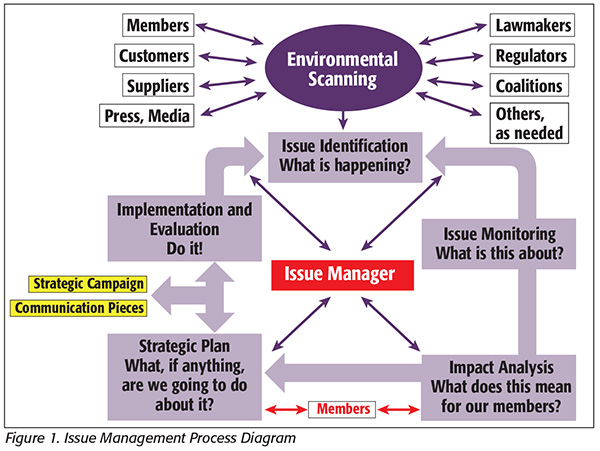I often come across people who are members of associations, either individually or through their companies or other organizations, but they don’t always know how to get the most out of their association dollar. As an association veteran, I know that these powerful organizations can be one of your best assets. They can help you do your job better. They can help solve problems that individuals or companies cannot do alone. They can help elect politicians who understand your business challenges. They can help you find camaraderie with your peers. They can even help you find a job or other opportunity through the relationships you build. Hopefully, this article will help you get the most out of the associations you belong to or even persuade you to join a new one.
What Do Associations Do?
Associations exist for a variety of reasons, so it is important to know the scope of an organization’s mission before joining. For example, trade associations are devoted to improving the business conditions of multiple lines of business, such as an industry or components of an industry within a geographical area. They can lobby legislative bodies and participate in political campaigns. Examples of food industry trade associations are the Northwest Food Processors Association (NWFPA), a regionally focused group, and the American Frozen Food Institute (AFFI) and the Grocery Manufacturers Association, which focus on national issues. Membership is generally by company, so many individuals may benefit from just one membership.
Scientific associations in the food industry are mostly for educational and research purposes, although some are involved in testing, standards setting and other activities. These organizations are very restricted in the lobbying activities in which they may engage. Examples of scientific associations would be the Institute of Food Technologists or the International Association for Food Protection (IAFP). These memberships are usually at the individual level.
What associations cannot do is participate in activities prohibited by antitrust laws. That means members cannot attempt to control or even suggest pricing, or conduct any activities that encourage more uniform pricing among competitors. Competitors can, under certain circumstances, agree jointly not to do business with targeted individuals or businesses, otherwise known as boycotting. There are a number of other activities that would raise antitrust concerns.
How Do Associations Work?
Generally, associations are established to be a voice of a group of organizations or individuals. Their purpose is to address issues of concern to all or a group of members.
Many associations are involved in “issue management”—a strategic management discipline first articulated in the 1970s in the public affairs industry—a process used when a gap exists between the expectations of a stakeholder (regulatory agency, legislative body, advocacy groups, the public, etc.) and the association members’ policies, performance, products or public commitments. Issue management is the process used to close that gap.
Examples of food safety and/or policy issues are:
The Food Safety Modernization Act – At all stages, associations participated in recognizing and closing the gaps between current business practices and those expected by lawmakers and the public. When the law was before Congress, associations helped negotiate the language of the bill to reflect its intent, which was to standardize the best practices of food safety systems. When the law was enacted, associations worked to help shape the proposed regulatory language to reflect and be compatible with the complexities of the food industry. Now that many of the rules have been finalized, associations are working to train and assist members with implementation challenges.
Foodborne pathogens – For decades, associations have been instrumental in industrywide continuous improvement of pathogen control in food products through guidance, education, policy development, training and research. Currently, the Alliance for Listeriosis Prevention, a national coalition of associations from many food sectors, works to reduce the incidence of Listeria contamination in food products by sharing information and resources for the benefit of the whole food supply.
 Figure 1 illustrates the issue management process. It begins with environmental scanning to identify emerging trends. Through environmental scanning, issue identification takes place, ideally very early before the trend becomes a societal norm, when influencing the outcome is more likely.
Figure 1 illustrates the issue management process. It begins with environmental scanning to identify emerging trends. Through environmental scanning, issue identification takes place, ideally very early before the trend becomes a societal norm, when influencing the outcome is more likely.
Issue monitoring is the process of gathering information about the issue and is critical to impact analysis. The process of prioritization will determine whether anything will or can be done and will drive strategic development. Impact analysis and strategic development are the critical steps that lead to implementation of the strategic plan and must involve member input. Evaluation of progress throughout implementation provides feedback for strategy adjustment and the identification of new issues.
Throughout this process, an issue manager’s intelligence infrastructure—his environmental relationships—is key to good environmental scanning. This infrastructure relies on continuous scanning of:
• Members, their suppliers and their customers via member visits, committee meetings, community networks, scheduled phone calls, supplier-member contact, industry meetings and conferences
• Regulators through advisory groups and ad hoc gatherings, industry and regulatory conferences and meetings, agency visits
• Lawmakers and their staff in lobbying calls, district visits, facility tours, hearings, relationships with lawmakers’ staff, pre-session legislative concepts
• Coalition partners by serving on their boards and committees, subscribing to newsletters, regular contact
• Press, social media, etc., including trade and mainstream press outlets, blogs, e-publications, clipping
services
• Other stakeholders with interest in the food processing industry through academic advisory boards, advocacy meetings and staff relationships
Once an issue is identified, members become critical partners in assessing the gap—the impact on their business, research needs, etc. Their feedback can help issue managers assess the overall impact on the membership, including:
• How many members are affected?
• What is the impact on members’ product, process, policy, practice, reputation, profit or facility?
• Does the issue involve market competitiveness issues between member companies?
• How severe is the impact of the issue on the affected members’ businesses?
• What are the long-term repercussions of the potential outcomes if we do not work on this issue?
• Does any other organization work on the issue? Are there potential gaps in the way that organization would work on the issue that would not adequately serve our membership?
• Who are potential collaborators and/or coalition partners to help work on the issue? What are their areas of convergence/divergence on the issue? What is their level of expertise with regard to the issue?
• What research is needed to understand fully the issue and its impact on the membership? What resources are needed to conduct the research?
• What are the relevant questions about the issue and its impact?
• What does the relevant oversight committee think?
• Does the issue fall into the area of responsibility for more than one staff member?
Finally, strategic planning is another step where member involvement is essential. It is a partnership between staff and members to employ the skills unique to each role. Staff provides the knowledge and experience of the tools for working on issues in the various stakeholder communities, while members provide impact assessment of strategic actions.
As a plan is implemented, staff and members participate in evaluation of the results, adjustment of priorities and plan, and identification of new issues.
How to Use Your Association
How an association works is critical to members’ understanding of how to use it. The process I’ve outlined shows that in a strong, member-driven association, the process is incomplete without the participation of the members. This is at the core of the confusion I’ve seen—members tend to think that initiatives are driven by staff and don’t understand their own role in harnessing the power of voice to solve problems that they or their organizations can’t do alone.
In addition to these larger strategic goals, however, there are a number of benefits to individuals who take time to involve themselves in association business. Here are some tips on how to take advantage of those benefits:
Get to know the issue managers
Issue managers are always glad to get a call or email from members. Tell them what your issues or concerns are. They depend on that input to do their own jobs. In return, they can:
• Provide you with an industrywide viewpoint. In the process of environmental scanning, they are talking to people inside and outside the industry on a daily basis and have a good ability to “connect the dots” on what’s trending or emerging.
• Speak for you with an anonymous voice. Questions or comments that you have but don’t want to voice as an individual or company can be voiced through the issue manager. Relationships built in the environmental scanning process make it easier for the issue manager to make a warm call on your behalf.
• Learn about your issues so that, when conducting their environmental scans, issue managers can keep an eye out for developments that can help or hurt you. In addition, they can help you identify people who can assist you in solving your problems.
• Be your advocate. When you find yourself in a bad situation, an association staff person can be a good ally.
Get involved with committees
Committees vary according to the association and its mission, but at the NWFPA, we have the following committees that are similar in structure to those at many other trade associations:
• Government affairs – Political, legislative issues
• Professional development – Operations and technical affairs, environmental affairs, energy, sustainability, all include technical and regulatory affairs
• Executive leadership – Strategic direction, governance, financial management
Involvement in committees can be very beneficial to your company and you, both professionally and personally. Committees help:
• Develop relationships with others in your professional discipline. These people can help you solve mutual problems. They can provide professional and personal support to help you face your challenges.
• Provide targeted education about the issues you care about. Good committee meetings should address these issues and provide the resources you need to understand the specific challenges you face.
• Initiate research that is a shared need across a sector of the membership.
• Analyze industry standards to help you gauge your own or your company’s standing in the industry community.
• Share intelligence about compliance, customer expectations or other stakeholder activities of interest to you or your business.
• Prevent crises, like recalls, address warning letters and manage customer expectations by learning the nuances of compliance.
• Provide a forum to get to know key regulators and other stakeholders.
• Assist with developing your leadership skills through committee participation and management. Staff representatives can assist you with industry perspective and leadership support to help you gain confidence with successively wider industry audiences, starting with committee projects and on through the board chair’s position.
Go to events
Events are tailored by association staff to meet the educational and training needs of their membership. They can be some of the best-value events for take-home knowledge that you attend. If they’re not, then you have direct-line feedback for improvement. As a member, you have the ability to design your own content.
An example of how this is literally true is the Community Network Program at NWFPA (see “Issue Management in Action: The NWFPA Community Network Program”). Members in local “neighborhoods” of the Northwest food processing community have banded together to prioritize their own training needs and develop the exact content they want for their companies. Because of the volume of attendees supported by the network, NWFPA can organize the events locally and bring the very best experts directly to the community. The processors benefit with great training at low cost because of volume purchasing, no travel costs and minimum downtime. Everyone wins!
By attending events hosted by your association, you are providing financial support to the organization. You expose yourself to resources and solution providers who also support the organization. You also develop relationships you might not form anywhere else. Attending events like IAFP’s annual meeting puts you in touch with academic and regulatory researchers with whom you wouldn’t cross paths anywhere else. Trade association meetings like NWFPA or AFFI give you the opportunity to meet the regulators you might meet only when they’re in your facility, possibly in a contentious situation. Having a strong, trusting relationship before that happens can help you work through difficult times.
Conclusion
Joining an association is like buying a house. The dues you pay are just the first investment. After that, you must maintain your membership through participation and support to get all you can out of it. As a member, you have a share in the ownership of the organization.
Hopefully, by seeing the association through the eyes of the issue manager, you understand better how to justify the investment you’ve made. If you’re contemplating joining an association and need support from your management, maybe some of these pointers will help you justify the investment in benefits for the company.
Prior to starting her own food safety/policy consulting business in 2015, Connie Kirby, M.Sc., served the NWFPA members as their vice president, scientific and technical affairs. She was the 2015 recipient of the Food Safety Magazine Distinguished Service Award. She resides in Portland, OR.




